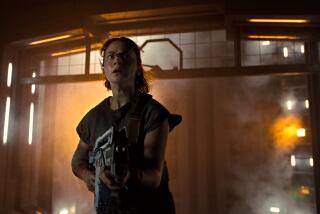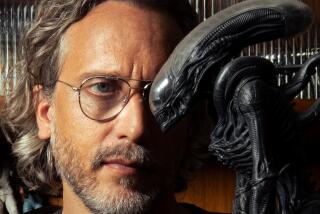To think like the masters
Bayonne, N.J., has so far been spared an invasion from outer space. But the attack it suffers in Steven Spielbergâs âWar of the Worldsâ is beyond familiar. Terrified residents rush through the streets covered in ash and dust; handmade missing-person posters line the sidewalks; commercial airliners fall from the sky, to be instantly scavenged by predatory news media; pieces of clothing rain down from above.
The first major studio release to reference the Sept. 11 terrorist attacks on New York, âWar of the Worldsâ does so strictly in the context of a midsummer popcorn doomsday scenario. No iconic national monuments were harmed in the making of the picture, and neither are any real-life players named. Even H.G. Wellsâ Martians have been replaced by a menace from someplace not worth mentioning, so as to avoid offending possible members of the extraterrestrial community. Still, the citations are relentless. In the movie, as in reality, the attackers donât come out of the clear blue; they were right under our feet, dormant and awaiting instruction. âIs it the terrorists?â shrieks Dakota Fanning, who plays Tom Cruiseâs daughter, Rachel, as the first wave of attacks hits their neighborhood. Well, Rachel, itâs complicated.
What is pretty clear is that with âWar of the Worldsâ Spielberg does more than cap his four-decade-spanning aliens-in-America trilogy, which began in 1977 with âClose Encounters of the Third Kindâ and left off in 1982 with âE.T.: The Extra-Terrestrial.â Unless, of course, you count âThe Terminal,â in which the stranded extraterrestrial was played by Tom Hanks and a mall/food court at JFK stood in, without a trace of irony, for the American way of life. Spielberg seems to have been in a revisionist mood of late, and âWar of the Worldsâ in many ways feels like a rebuke to his younger self. In interviews, he has called his new movie âa polar oppositeâ to âClose Encounters.â âIâve grown up a lot,â heâs said. âIâm a father now. I would never have made that film after having children.â (That would have been our loss.) Not surprisingly, the promotional campaign for âWar of the Worldsâ has been flogging this aspect of the creation myth of Spielberg-the-artist accordingly: A boyâs father directs his attention to the stars and then abandons him; a sequence of events then fixes him (as if heâd crossed his eyes in a breeze) on the idea of a faraway world populated by superior beings who wouldnât dream of doing such things.
But âWar of the Worldsâ runs counter to âClose Encountersâ in more ways than that. Spielbergâs longevity as an artist, his matchless success over the years, and his preoccupation with a closed set of themes have yielded a series of snapshots of not just his own but also his generationâs evolving attitudes toward parenthood, government and what those things have in common. Spielbergâs early films (âJaws,â âClose Encountersâ) were marked by a sly baby-boomer antiestablishmentarianism that is hard to imagine him embracing now. In âClose Encounters,â Roy Neary (Richard Dreyfuss), a restless working stiff mired in domestic chaos, gets a glimpse of something transcendent and begins devoting his time to bizarre art projects involving shaving cream and mashed potatoes. Eventually, Roy loses his job and the respect of his community; he abandons his family and defies his government to put on a satin track suit and hop a mother ship to parts unknown.
What is Roy if not a perfect encapsulation of the attitudes of the Me Generation and of its yearning for exotic experiences to transcend the familiar, the local, the domestic? The movieâs hero leaves everything behind to explore an alternate lifestyle -- religious cult, ashram, spaceship, whatever -- far from home; to have his mind blown and his consciousness expanded by a tribe of mute albinos from another planet. And he gets there thanks to a French scientist, played by none other than French film auteur Francois Truffaut. No wonder âClose Encountersâ is still an art school favorite. It not only comprises a young personâs idea of what it means to be an artist (âThis is important,â Roy repeats several times throughout the movie. âThis means something.â And later, after meeting others who have experienced similar apparitions but been frustrated by the limitations of their art in expressing them, âYou should try sculptureâ), but it elevates his nonconformist personal vision above everything else.
If âClose Encountersâ offered a beautifully place- and time-specific portrait of the 1970s -- the Nearysâ suburban tract house, with its shabby, post-utopian air; the family captured in the throes of dissolution; the multiculti spiritualist promise of alien life -- âE.T.â was the pitch-perfect 1980s follow-up. âE.T.,â which turned its attention to the abandoned child, was a retraction and an apology. Elliott (Henry Thomas) is the middle son of a broken home. His father has recently decamped for Mexico with his new girlfriend, leaving Elliottâs working mom and lonely siblings unmoored in a development that smacks of another empty promise. But Spielbergâs longing for a life beyond the development is considerably less acute than it was in âClose Encounters.â In E.T., Elliott finds a fellow stranded kid longing for home. Elliott helps E.T. contact his family but asks him to stay. E.T. fills the void left by Elliottâs father for a while, but more importantly, he helps find him a replacement in the form of fellow alien-sympathizer Peter Coyote, who protectively puts his arm around Elliottâs mother as E.T.âs spaceship takes off. The cult has been replaced with the foreign exchange program.
DEMONIZED ALIENS
So what are we supposed to make of âWar of the Worldsâ? The tenets of Hollywood controversy avoidance, in extra-high gear during the summer months, would dictate that the movie hedge its ideological bets. The movieâs marketing asks that we take it as a simple parable about parental responsibility. The movie itself, by relentlessly referencing the terrorist attacks and cribbing from the war rhetoric to create its iconography (the aliens look like demons straight out of a painting by Hieronymus Bosch, in contrast to the glowing, celestial beings in âClose Encountersâ and the earthy, familiar E.T.), demands to be seen as a political allegory. Cruiseâs Ray Ferrier never stops being the hero, but itâs possible to detect the slightest shift in Spielbergâs point of view between the surprise attack, the invasion and the occupation. Or maybe not. For all its citing of 9/11, âWar of the Worlds,â coming as it does a full four years later, offers no catharsis at all. It doesnât even dare advance a theory, or a feeling. The distinct, surefooted point of view that once set Spielberg apart -- rebellious but sentimental, idealistic but humanistic -- now seems mired in conflict, confusion and compromise.
It goes without saying that âWar of the Worldsâ features no tolerant French scientist to facilitate communication between American government officials, half-cracked UFO enthusiasts and foreign visitors. The closest thing to a foreign culture that Ray encounters en route from New Jersey to Boston (and even Boston, home of the Red Sox, is stretching it for this die-hard Yankees fan) is Tim Robbins. Robbinsâ Harlan is a sweaty survivalist, pushed over the edge by the loss of his family, who invites Ray and his daughter to share his bunker and his food supply as the two exhausted refugees outrun yet another Tripod attack. (The gesture stands in stark contrast to Rayâs attitude toward his car, which he was less than willing to share with anyone.) At first, Ray is grateful to him -- until it becomes clear that Harlan wants the two of them to resist the alien occupation, which immediately brands him as a dangerous crackpot.
âOccupations never work,â Harlan says, and Ray looks at him as if heâs crazy. Fair enough. But if Harlan is a nut job for wanting to fight the alien invasion, heâs a creep for offering to usurp Rayâs role as father and protector of Rachel, should anything happen to Ray. (So for that matter is the woman in the field who mistakes Rachel for a lost child and tries to take her with her.) At this point, Ray has no choice but to blindfold Rachel and instruct her to clap her hands over her ears and sing a song while he dispatches Robbinsâ character with a shovel to the head.
In âClose Encounters,â the notion that government would try to hide the truth from people who had glimpsed it -- going so far as to fake an environmental disaster as a diversion -- wasnât exactly presented as a handy parenting tip. But this same impulse in âWar of the Worldsâ is offered as the last word in parental responsibility and love. Ray is forever covering Rachelâs eyes and instructing her not to look, to block out the world around her and trust him entirely-- even though he was never to be trusted before.
In Harlan, Spielberg has created a queasy, ever-shifting reflection of our current emotional morass: Is he meant to represent the insurgency? Is he a stand-in for antiwar activists? When the Goliath-like invaders succumb to tenacious local microbes, which Morgan Freemanâs narration tells us were put there by God, does it mean he was right all along? In the end, his most salient objectionable quality seems to be that he rubs Ray the wrong way. âYou and I arenât on the same page,â he says -- at which point we understand that Ray and Harlan are past looking, past listening, past asking questions, past turning on their heart lights.
In the end, although it flirts with other possibilities, the one course âWar of the Worldsâ never seems to veer from is the opinion that Rayâs tenacity, autocratic paternalism and willingness to âstay the courseâ are what eventually bring his kids to safety. Ultimately, Father knows best, even if he has no clue -- as Ray doesnât -- what the capital of Australia is. What matters is that he knows where they keep the grenades, and where to stick them. Itâs light-years away from Roy Neary and his all-important need for cosmic answers. Why ask why? Why even ask who? Humanity has survived countless horrors and will survive countless more. In the meantime, the film seems to say, just batten down the hatches, close your eyes, create your safe space and let Dad do the thinking for you.
*
Carina Chocano is a Times film critic. She can be contacted at [email protected].
More to Read
Only good movies
Get the Indie Focus newsletter, Mark Olsen's weekly guide to the world of cinema.
You may occasionally receive promotional content from the Los Angeles Times.










